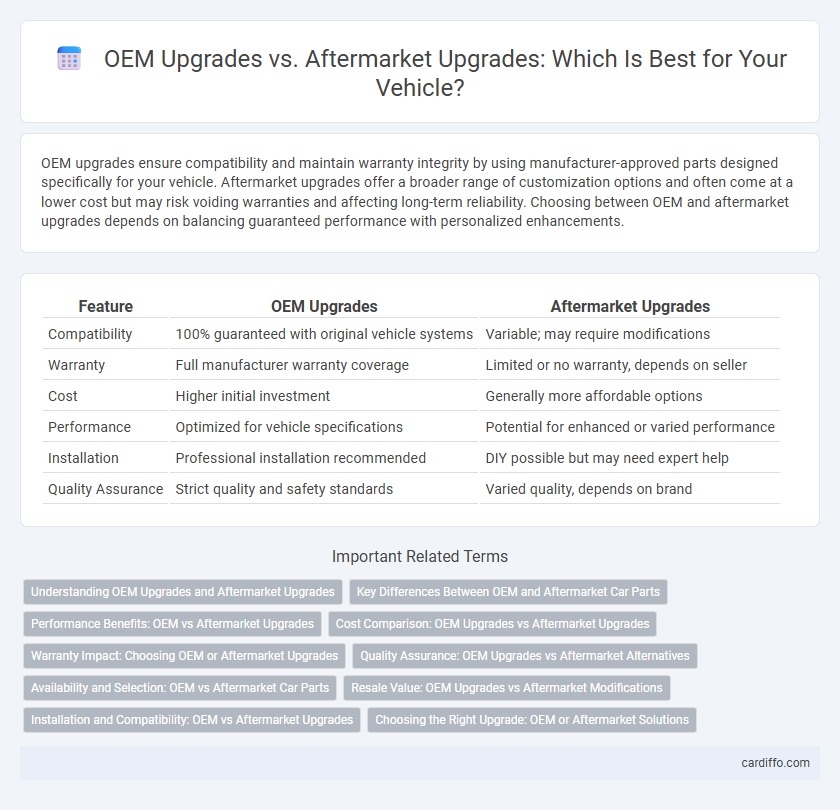OEM upgrades ensure compatibility and maintain warranty integrity by using manufacturer-approved parts designed specifically for your vehicle. Aftermarket upgrades offer a broader range of customization options and often come at a lower cost but may risk voiding warranties and affecting long-term reliability. Choosing between OEM and aftermarket upgrades depends on balancing guaranteed performance with personalized enhancements.
Table of Comparison
| Feature | OEM Upgrades | Aftermarket Upgrades |
|---|---|---|
| Compatibility | 100% guaranteed with original vehicle systems | Variable; may require modifications |
| Warranty | Full manufacturer warranty coverage | Limited or no warranty, depends on seller |
| Cost | Higher initial investment | Generally more affordable options |
| Performance | Optimized for vehicle specifications | Potential for enhanced or varied performance |
| Installation | Professional installation recommended | DIY possible but may need expert help |
| Quality Assurance | Strict quality and safety standards | Varied quality, depends on brand |
Understanding OEM Upgrades and Aftermarket Upgrades
OEM upgrades involve enhancements or replacements provided directly by the original equipment manufacturer, ensuring compatibility, warranty protection, and adherence to factory standards. Aftermarket upgrades are modifications or parts produced by third-party companies, often offering cost-effective options and a wider range of customization but may vary in quality and affect warranty coverage. Understanding the differences between OEM and aftermarket upgrades helps consumers make informed decisions based on reliability, performance, and budget considerations.
Key Differences Between OEM and Aftermarket Car Parts
OEM upgrades guarantee compatibility and maintain vehicle warranty by using parts produced by the original manufacturer, ensuring precise fit and consistent quality. Aftermarket upgrades offer a wider range of customization options and potentially lower costs but may vary in quality and fit, sometimes affecting vehicle performance or warranty validity. Choosing between OEM and aftermarket parts depends on priorities like performance, cost, and reliability in vehicle maintenance or enhancement.
Performance Benefits: OEM vs Aftermarket Upgrades
OEM upgrades deliver performance improvements that are specifically engineered to meet the vehicle manufacturer's standards, ensuring seamless compatibility and reliability. Aftermarket upgrades often provide enhanced power, handling, or fuel efficiency, but may vary widely in quality and require careful selection to avoid potential issues. Choosing OEM parts typically guarantees optimal integration and consistent performance gains aligned with the original design.
Cost Comparison: OEM Upgrades vs Aftermarket Upgrades
OEM upgrades typically carry higher price tags due to brand-specific parts and guaranteed compatibility, while aftermarket upgrades often provide cost-effective alternatives with a broader range of options. Aftermarket parts may vary in quality and fit, which can influence long-term maintenance costs compared to OEM components designed for seamless integration. Evaluating total ownership expenses, including installation and durability, is critical when comparing cost efficiency between OEM upgrades and aftermarket solutions.
Warranty Impact: Choosing OEM or Aftermarket Upgrades
OEM upgrades maintain the original equipment manufacturer's warranty by using certified parts specifically designed for the vehicle, ensuring compatibility and reliability. Aftermarket upgrades may offer enhanced performance or cost savings but often risk voiding the manufacturer's warranty due to non-certified components. Vehicle owners should carefully review warranty terms and consult manufacturers before installing aftermarket parts to avoid potential coverage issues.
Quality Assurance: OEM Upgrades vs Aftermarket Alternatives
OEM upgrades ensure consistent quality assurance by adhering to original manufacturer specifications and rigorous testing protocols, minimizing compatibility risks and maintaining vehicle warranty integrity. Aftermarket upgrades may offer cost savings and customization but often lack standardized quality controls, increasing the possibility of performance issues and voided warranties. Choosing OEM parts guarantees reliability and compliance with safety standards, crucial for long-term vehicle performance and owner peace of mind.
Availability and Selection: OEM vs Aftermarket Car Parts
OEM car parts offer guaranteed compatibility and are specifically designed for the vehicle model, ensuring reliable performance and warranty support. Aftermarket upgrades provide a wider selection with often more innovative features and competitive pricing, but compatibility and quality can vary by manufacturer. Availability of OEM parts may be limited to dealerships, while aftermarket parts are widely accessible through multiple retailers and online platforms.
Resale Value: OEM Upgrades vs Aftermarket Modifications
OEM upgrades typically preserve or enhance resale value due to their factory-approved quality and compatibility with the vehicle's original design. Aftermarket modifications can reduce resale value as potential buyers may be wary of non-standard parts, which could affect reliability and warranty coverage. Vehicles with OEM upgrades often command higher prices in the used car market compared to those with extensive aftermarket alterations.
Installation and Compatibility: OEM vs Aftermarket Upgrades
OEM upgrades ensure seamless installation and full compatibility with existing vehicle systems, as they are designed and tested by the original manufacturer. Aftermarket upgrades may offer more variety and customization options but often require modifications and carry risks of compatibility issues or voiding warranties. Choosing OEM parts prioritizes reliability and ease of integration, while aftermarket parts demand careful assessment of fitment and technical specifications.
Choosing the Right Upgrade: OEM or Aftermarket Solutions
Choosing the right upgrade depends on factors like compatibility, warranty, and performance needs; OEM upgrades ensure perfect fit and manufacturer support, while aftermarket options offer cost-effectiveness and customization. OEM parts maintain original specifications, reducing risks of installation errors and preserving vehicle integrity. Aftermarket upgrades provide a wide range of features and styles but require careful evaluation to match quality and reliability standards.
OEM upgrades vs aftermarket upgrades Infographic

 cardiffo.com
cardiffo.com